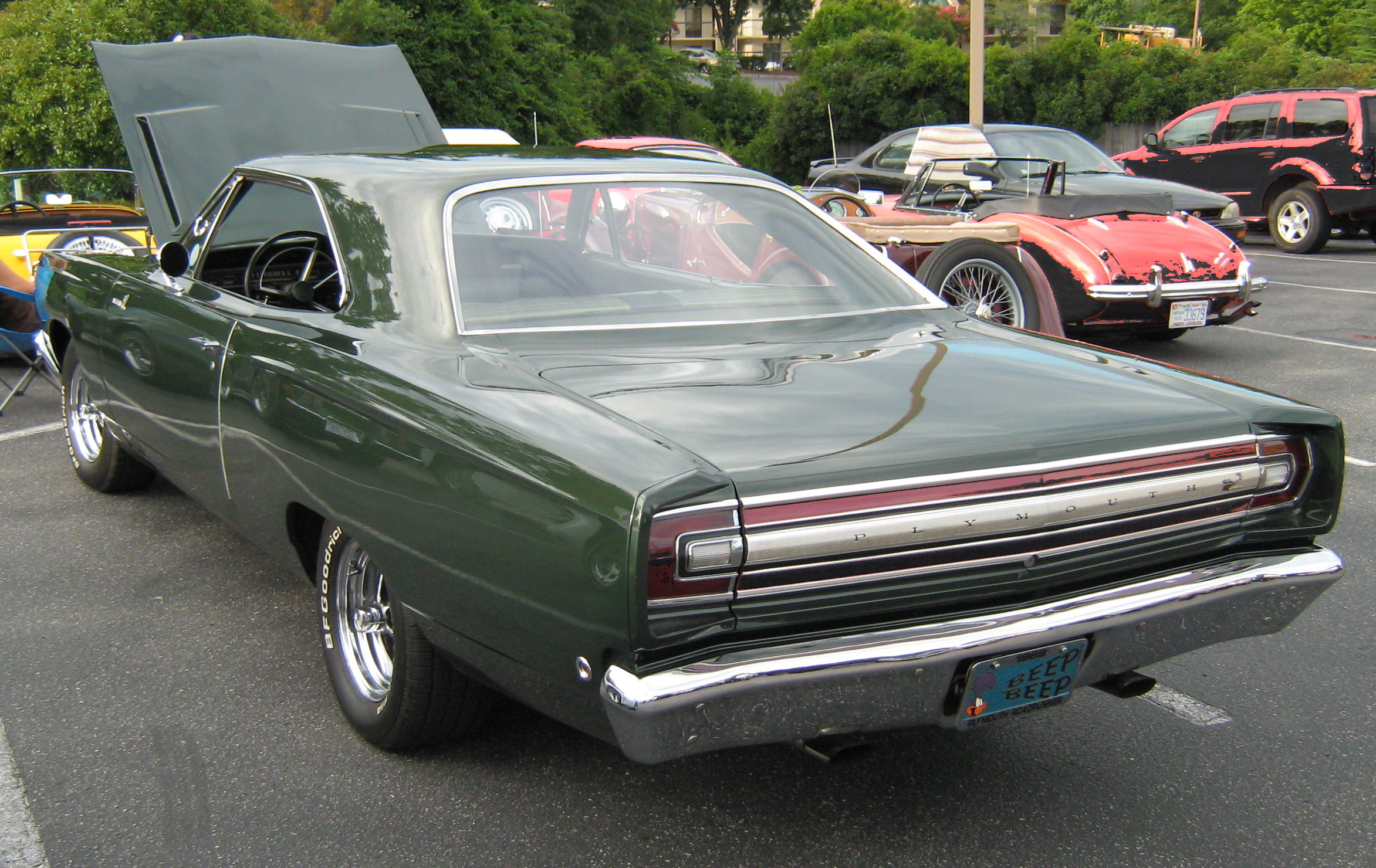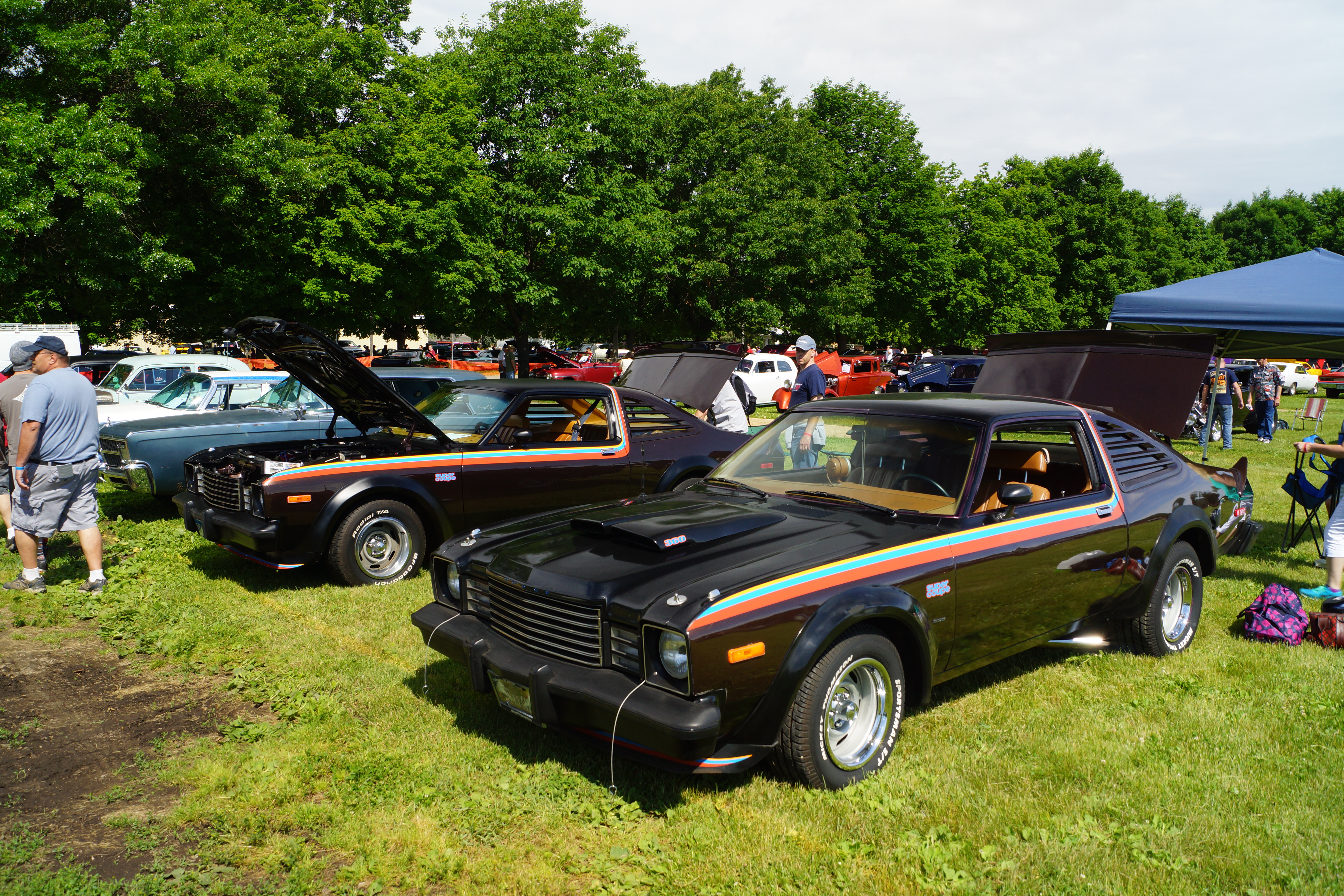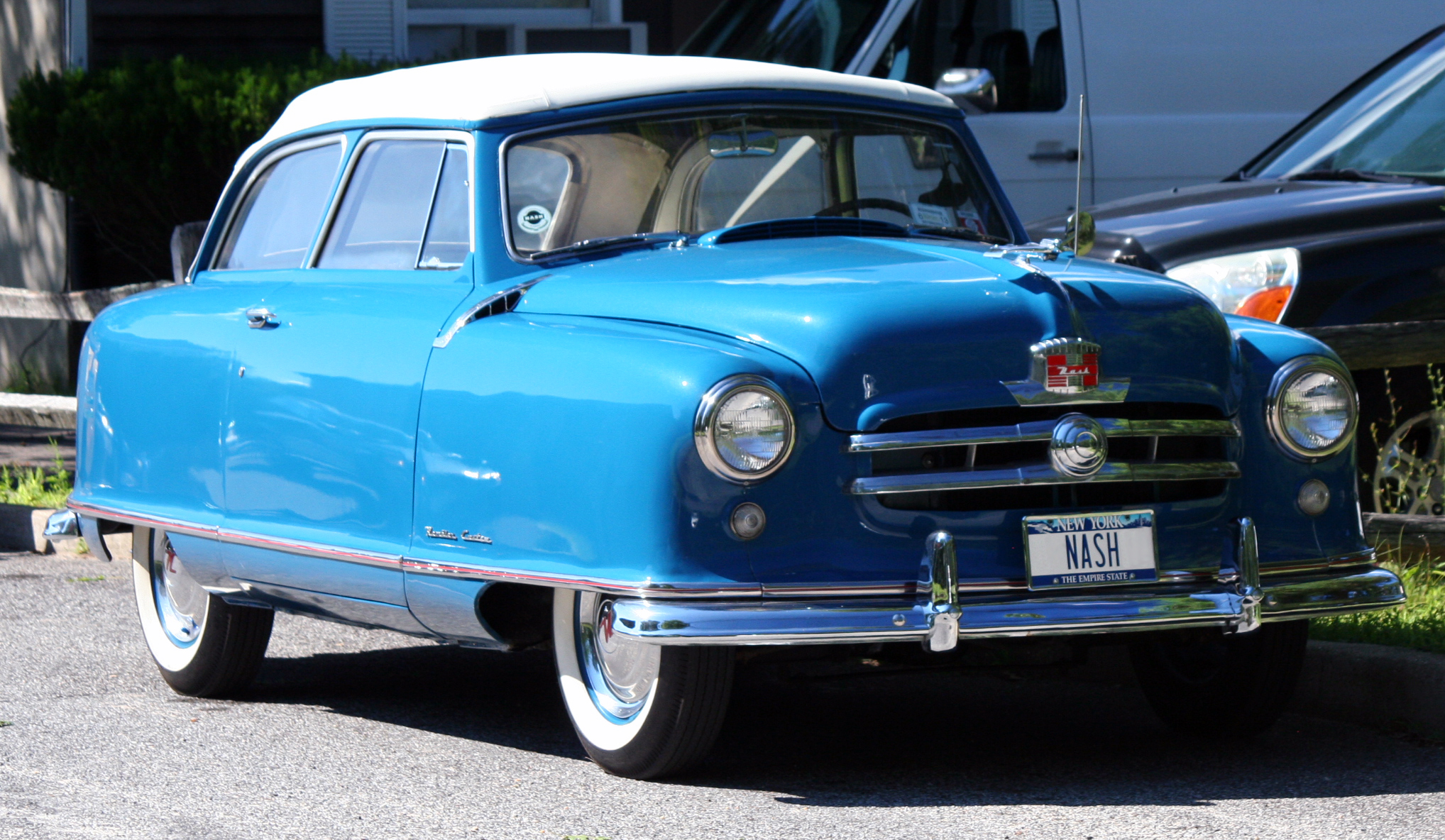|
Plymouth Road Runner
The Plymouth Road Runner is a muscle car introduced by Chrysler in the United States for the 1968 model year and marketed under its Plymouth brand. Initially based on the Belvedere, the brand's basic mid-size model, the Road Runner combined a powerful engine with a spartan trim level and a price that undercut increasingly upscale and expensive muscle cars such as the Pontiac GTO and Plymouth's own GTX. It was initially a sales success. The Road Runner was built in three generations on the mid-size B platform. Like most muscle cars, its performance and sales declined in the 1970s due to an increasing focus on fuel economy and the adoption of more stringent U.S. emission standards. The nameplate became to a trim package for the compact Plymouth Volaré for model year 1976—no longer offering any special performance capability—and was discontinued in 1980. Origin Plymouth paid $50,000 to Warner Bros.-Seven Arts to use the Road Runner name and likeness from their Wile E. ... [...More Info...] [...Related Items...] OR: [Wikipedia] [Google] [Baidu] |
Detroit
Detroit ( , ) is the List of municipalities in Michigan, most populous city in the U.S. state of Michigan. It is situated on the bank of the Detroit River across from Windsor, Ontario. It had a population of 639,111 at the 2020 United States census, 2020 census, making it the List of United States cities by population, 26th-most populous city in the United States and the largest U.S. city on the Canada–United States border. The Metro Detroit area, home to 4.3 million people, is the second-largest in the Midwestern United States, Midwest after the Chicago metropolitan area and the 14th-largest in the United States. The county seat, seat of Wayne County, Michigan, Wayne County, Detroit is a significant cultural center known for its contributions to music, art, architecture and design, in addition to its historical automotive and industrial background. In 1701, Kingdom of France, Royal French explorers Antoine de la Mothe Cadillac and Alphonse de Tonty founded Fort Pontc ... [...More Info...] [...Related Items...] OR: [Wikipedia] [Google] [Baidu] |
Pontiac GTO
The Pontiac GTO is a front-engine, rear-drive, two-door, and four-passenger automobile manufactured and marketed by the Pontiac (automobile), Pontiac division of General Motors over four generations from 1963 until 1974 in the United States — with a fifth generation made by GM's Australian subsidiary, Holden, for the 2004 through 2006 model years. The first generation of the GTO is credited with popularizing the muscle car market segment in the 1960s. Some consider the Pontiac GTO to have started the trend with all four domestic automakers offering a variety of competing models. For the 1964 and 1965 model years, the GTO was an optional package on the intermediate-sized Pontiac LeMans. The 1964 GTO vehicle identification number (VIN) started with 22, while the 1965 GTO VIN began with 237. The GTO was designated as a separate Pontiac model from 1966 through 1971 (VIN 242...). It became an optional package again for the 1972 and 1973 intermediate LeMans. For 1974, the GTO ... [...More Info...] [...Related Items...] OR: [Wikipedia] [Google] [Baidu] |
Coupe
A coupe or coupé (, ) is a passenger car with a sloping or truncated rear roofline and typically with two doors. The term ''coupé'' was first applied to horse-drawn carriages for two passengers without rear-facing seats. It comes from the French past participle of , "cut". Some coupé cars only have two seats, while some also feature rear seats. However, these rear seats are usually lower quality and much smaller than those in the front. Furthermore, "A fixed-top two-door sports car would be best and most appropriately be termed a 'sports coupe' or 'sports coupé'". __TOC__ Etymology and pronunciation () is based on the past participle of the French verb ("to cut") and thus indicates a car which has been "cut" or made shorter than standard. It was first applied to horse-drawn carriages for two passengers without rear-facing seats. These or ("clipped carriages") were eventually clipped to .. There are two common pronunciations in English: * () – the anglicized ... [...More Info...] [...Related Items...] OR: [Wikipedia] [Google] [Baidu] |
V8 Engine
A V8 engine is an eight- cylinder piston engine in which two banks of four cylinders share a common crankshaft and are arranged in a V configuration. Origins The first known V8 was the Antoinette, designed by Léon Levavasseur, and built in 1904 by the French Antoinette company for use in speedboat racing, cars, and later, airplanes. Also in 1904, V8 engines began small-scale production by Renault and Buchet for use in race cars. Design V-angle Most engines use a V-angle (the angle between the two banks of cylinders) of 90 degrees. This angle results in good engine balance, which results in low vibrations. However, the downside is the greater width of the engine compared to those that use a smaller V-angle. V8 engines with a 60-degree V-angle were used in the 1996–1999 Ford Taurus SHO, the 2005–2011 Volvo XC90, and the 2006–2009 Volvo S80. The Ford engine used a 60-degree V-angle because it was based on a V6 engine with a 60-degree V-angle. ... [...More Info...] [...Related Items...] OR: [Wikipedia] [Google] [Baidu] |
Manual Transmission
A manual transmission (MT), also known as manual gearbox, standard transmission (in Canadian English, Canada, British English, the United Kingdom and American English, the United States), or stick shift (in the United States), is a multi-speed motor vehicle Transmission (mechanical device), transmission system where gear changes require the driver to manually select the gears by operating a gear stick and clutch (which is usually a foot pedal for cars or a hand lever for motorcycles). Early automobiles used ''sliding-mesh'' manual transmissions with up to three forward gear ratios. Since the 1950s, ''constant-mesh'' manual transmissions have become increasingly commonplace, and the number of forward ratios has increased to 5-speed and 6-speed manual transmissions for current vehicles. The alternative to a manual transmission is an automatic transmission. Common types of automatic transmissions are the Automatic transmission#Hydraulic automatic transmissions, hydraulic automatic ... [...More Info...] [...Related Items...] OR: [Wikipedia] [Google] [Baidu] |
Automatic Transmission
An automatic transmission (AT) or automatic gearbox is a multi-speed transmission (mechanics), transmission used in motor vehicles that does not require any input from the driver to change forward gears under normal driving conditions. The 1904 Sturtevant "horseless carriage gearbox" is often considered to be the first true automatic transmission. The first mass-produced automatic transmission is the General Motors ''Hydramatic'' two-speed hydraulic automatic, which was introduced in 1939. Automatic transmissions are especially prevalent in vehicular drivetrains, particularly those subject to intense mechanical acceleration and frequent idle/transient operating conditions; commonly commercial/passenger/utility vehicles, such as buses and waste collection vehicles. Prevalence Vehicles with internal combustion engines, unlike electric vehicles, require the engine to operate in a narrow range of rates of rotation, requiring a gearbox, operated manually or automatically, to drive t ... [...More Info...] [...Related Items...] OR: [Wikipedia] [Google] [Baidu] |
Beep, Beep (sound)
"Beep, beep" is onomatopoeia representing a noise, generally of a pair of identical tones ( beeps) following one after the other, often generated by a machine or device such as a car horn. It is commonly associated with the Road Runner (commonly interpreted as "meep meep") in Looney Tunes cartoons featuring the speedy-yet-flightless bird and his constant pursuer, Wile E. Coyote. '' Beep, Beep'' is the name of a 1952 Warner Bros. cartoon in the '' Merrie Melodies'' series. Road Runner cartoons Chuck Jones, the creator of Road Runner, has stated that this sound, the only way the Road Runner can harm the Coyote, was inspired by hearing a Doppler-like effect as background artist Paul Julian imitated a car horn when he could not see where he was going. Julian voiced the various recordings of the phrase used throughout the Road Runner cartoons, although on-screen he was uncredited for his work. Although commonly quoted as "meep meep", Warner Bros., the current owner of all trade ... [...More Info...] [...Related Items...] OR: [Wikipedia] [Google] [Baidu] |
Wile E
Wile may refer to: People * John Wile (born 1947), English football player and manager * Matt Wile (born 1992), American football player Arts, entertainment, and media * WILE (AM), a radio station (1270 AM) licensed to Cambridge, Ohio, United States * WILE-FM, a radio station (97.7 FM) licensed to Byesville, Ohio, United States * Wile E. Coyote, a character of Looney Tunes Other uses * M. Wile and Company Factory Building, in Buffalo, NY, USA * Wile Cup, a croquet trophy initiated at the University of British Columbia See also * * While (other) * Wiles (other) {{Disambiguation, callsign ... [...More Info...] [...Related Items...] OR: [Wikipedia] [Google] [Baidu] |
Warner Bros
Warner Bros. Entertainment Inc. (WBEI), commonly known as Warner Bros. (WB), is an American film studio, filmed entertainment studio headquartered at the Warner Bros. Studios Burbank, Warner Bros. Studios complex in Burbank, California and the main namesake subsidiary of Warner Bros. Discovery (WBD). Founded on April 4, 1923, by four brothers, Harry Warner, Harry, Albert Warner, Albert, Sam Warner, Sam and Jack L. Warner, Jack Warner, the company established itself as a leader in the American film industry before diversifying into animation, television, and video games. It is one of the "Major film studios, Big Five" major American film studios and a member of the Motion Picture Association (MPA). The company is known for its film studio division, the Warner Bros. Motion Picture Group, which includes Warner Bros. Pictures, New Line Cinema, Warner Bros. Pictures Animation, Castle Rock Entertainment and the Warner Bros. Television Group. Bugs Bunny, a character created for the ' ... [...More Info...] [...Related Items...] OR: [Wikipedia] [Google] [Baidu] |
Plymouth Road Runner 1969 Emblem LakeMirrorClassic 17Oct09 (14598616764)
Plymouth ( ) is a port city and unitary authority in Devon, South West England. It is located on Devon's south coast between the rivers Plym and Tamar, about southwest of Exeter and southwest of London. It is the most populous city in Devon. Plymouth's history extends back to the Bronze Age, evolving from a trading post at Mount Batten into the thriving market town of Sutton, which was formally re-named as Plymouth in 1439 when it was made a borough. The settlement has played a significant role in English history, notably in 1588 when an English fleet based here defeated the Spanish Armada, and in 1620 as the departure point for the Pilgrim Fathers to the New World. During the English Civil War, the town was held by the Parliamentarians and was besieged between 1642 and 1646. In 1690 a dockyard was established on the River Tamar for the Royal Navy and Plymouth grew as a commercial shipping port throughout the Industrial Revolution. After absorbing nearby settlements in 19 ... [...More Info...] [...Related Items...] OR: [Wikipedia] [Google] [Baidu] |
Plymouth Volaré
The Dodge Aspen, and its badge engineered variant, the Plymouth Volaré, are compact rear-drive cars manufactured and marketed by Chrysler for model years 1976-1980 in four-door sedan, two-door coupe, and four-door wagon styles. During the Volaré/Aspen's production, North American automakers were actively "downsizing" their lineups, reducing size and weight for improved fuel economy — and the industry was reclassifying its size nomenclature. The Volaré/Aspen were thus classified originally as compact cars and as intermediate-sized cars by the time their production ended. The Volaré/Aspen were discontinued following the 1980 model year prior to the introduction of the front-wheel-drive Plymouth Reliant and Dodge Aries, known collectively as K-cars. Background The Volaré and the Aspen were introduced mid-cycle for model year 1976 as successors to the Chrysler " A-platform" models, the Plymouth Valiant/ Plymouth Duster and Dodge Dart. During the 1976 model year, Va ... [...More Info...] [...Related Items...] OR: [Wikipedia] [Google] [Baidu] |
Compact Car
Compact car is a vehicle size class—predominantly used in North America—that sits between subcompact cars and mid-size cars. "Small family car" is a British term and a part of the C-segment in the European car classification. However, before the downsizing of the United States car industry in the 1970s and 1980s, larger vehicles with wheelbases up to were considered "compact cars" in the United States. In Japan, small size passenger vehicle is a registration category that sits between kei cars and regular cars, based on overall size and engine displacement limits. United States Current definition The United States Environmental Protection Agency (EPA) ''Fuel Economy Regulations for 1977 and Later Model Year'' (dated July 1996) includes definitions for classes of automobiles. Based on the combined passenger and cargo volume, compact cars are defined as having an ''interior volume index'' of . 1930s to 1950s The beginnings of U.S. production of compact cars were the ... [...More Info...] [...Related Items...] OR: [Wikipedia] [Google] [Baidu] |










